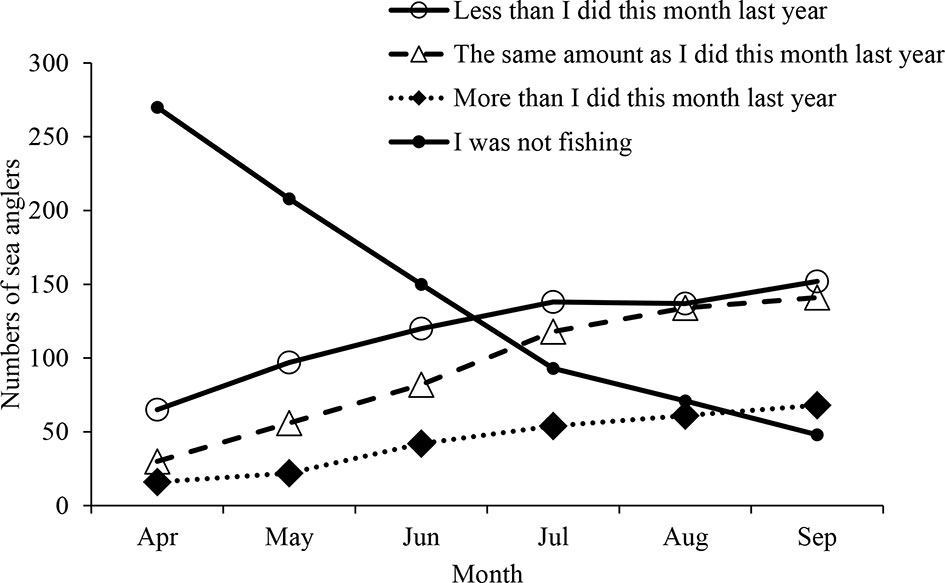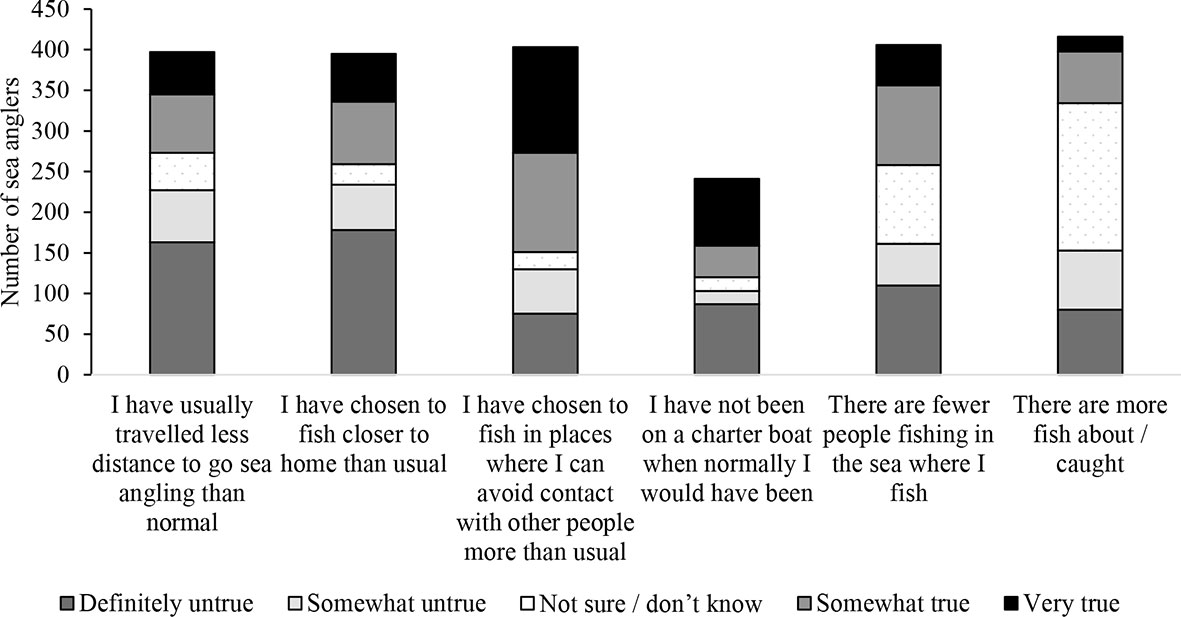The Impact of COVID-19 on Participation, Effort, Physical Activity, and Well-Being of Sea Anglers in the UK
- 1Substance, Canada House, Manchester, United Kingdom
- 2Radical Data, Amsterdam, Netherlands
- 3Centre for Environment, Fisheries and Aquaculture Science (Cefas), Lowestoft, United Kingdom
- 4Biosciences, University of Exeter, Exeter, United Kingdom
- 5School of Environmental Sciences, University of East Anglia, Norwich Research Park, Norwich, United Kingdom
Recreational sea angling is an important recreational activity in the United Kingdom with around 1.6% of adults participating and a total economic impact of around £1.5 billion each year. There are positive impacts of angling on physical health and mental well-being. The COVID-19 pandemic resulted in several national lockdowns in the UK, which along with additional local restrictions and personal circumstances due to the pandemic, have impacted people’s ability to fish. Angling was not allowed in the UK for some of the first lockdown (March to May 2020), and further restrictions were implemented subsequently that varied between the countries and regions. The impact of COVID-19 on the participation, effort, physical activity, and well-being of UK sea anglers remains unknown. A panel of UK sea anglers, which record their activity and catches as part of the Sea Angling Diary Project, were surveyed to assess changes in sea angling participation, physical activity, mental well-being, and expenditure between 2019 and 2020. We compared the sea angling effort and catches of the diary panel between 2019 and 2020. We found reduced sea angling effort in the panel, including sessions and catches, between 2019 and 2020, with the largest impact being in April 2020. We found that there was a significant reduction in expenditure during April 2020 with 64% of respondents spending less on sea angling than in a typical April. In total, 67% of respondents reported reduced happiness and 45% were less active due to sea angling restrictions. Using a general linear model, we found that even though anglers said that being able to go fishing has resulted in high World Health Organization Five Well-being Index scores, other factors also had significant effects. These included: age; physical and mental health status; angling activity; travel to fish during COVID-19; and whether they fished in July 2020. Of those who responded, 66% classified themselves as at either high or moderate risk to COVID-19. This work has shown that COVID-19 has negatively affected marine recreational fisheries in the UK, and not being able to go sea angling has negatively impacted participation, effort, physical activity and well-being.
Introduction
Marine recreational fisheries are important activities creating economic impacts (Cisneros-Montemayor and Sumaila, 2010; Hyder et al., 2017, 2018) and social benefits through physical health and well-being (Mcmanus et al., 2011; Armstrong et al., 2013; Griffiths et al., 2017), but can also impact on fish stocks (Hyder et al., 2017; Hyder et al., 2018; Radford et al., 2018; Lewin et al., 2019). Marine recreational fisheries (MRF) are generally not embedded in governance structures in many countries (Arlinghaus et al., 2019; Potts et al., 2020) and is often unlicensed meaning that the participants are not well characterized (Hyder et al., 2017; Hyder et al., 2020b). Motivation for participating in MRF is diverse (Fedler and Ditton, 1994; Arlinghaus, 2006; Beardmore et al., 2011), making responses of fishers difficult to predict [e.g. for the management of marine recreational fisheries and to understand and monitor climate change (Arlinghaus et al., 2016)]. Sea angling using rod and line is the most common form of MRF in the UK (Armstrong et al., 2013; Hyder et al., 2020a; Hyder et al., 2021), with over 700,000 participants fishing for over 6 million days and catching over 40 million fish a year (Hyder et al., 2020a; Hyder et al., 2021). Sea anglers in the UK generate a total economic impact of over £1.5 billion, supporting over 13,000 jobs (Hyder et al., 2020a). In addition, sea angling in the UK has benefits to the individual (e.g. physical health and well-being) and societal benefits (e.g. environmental improvement work and volunteering) (Armstrong et al., 2013).
In 2019, the outbreak of COVID-19, led to a global pandemic from early 2020 through to at least the date of this publication (World Health Organization, 2020). Governments across the globe began to react with designed measures to control the spread of the virus (Hiscott et al., 2020). In particular, multiple governments created national lockdowns and other restrictions to reduce social interaction (Hiscott et al., 2020), such as limiting travel (Iacobucci, 2020; Wilder-Smith and Freedman, 2020) and access to non-essential activities (Ding et al., 2020; Storr et al., 2021).
The COVID-19 pandemic has been shown to have an impact on MRF across the world (Skov & Gundelund, 2021; Pita et al., 2021). The potential for impacts on MRF varied between countries as the restrictions on activities differed (Pita et al., 2021). In the UK, the number and duration of lockdowns and associated restrictions varied between the different countries and regions and were complex (Pita et al., 2021) resulting in varying impacts on sea angling spatially and temporally. At the beginning of the COVID-19 pandemic, UK lockdowns restricted people’s ability to participate in recreational angling in both fresh and saltwater. From the 23rd March to the 13th May 2020, any form of angling was completely banned in the UK (Institute for Government, 2021). After this, there were a series of varying restrictions at UK, national (devolved administration), regional and city levels. Other factors relating to the pandemic, including infection, requirements to ‘shield’, restrictions on travel and personal decisions about safety will also have impacted people’s ability to participate in sea angling. However, the impact of COVID-19 on the participation and effort, physical activity, and well-being of UK sea anglers remains largely unknown.
There is a wealth of evidence that shows that participating in sport and active recreation can improve physical health and well-being (McNally et al., 2015). Whilst some research has sought to identify the benefits that outdoor recreation can have for participants (Benefits of Outdoor Sport for Society; Eigenschenk et al., 2019), research on the health benefits of angling in general, and sea angling in particular, is limited (Mcmanus et al., 2011; Armstrong et al., 2013; Griffiths et al., 2017). In the UK, 72% of anglers in the National Angling Survey said that angling helped to keep them healthy, 27% said it was their main way of being physically active and 70% said it helped them deal with stress (Brown, 2019). It is estimated that around 1.6% of UK adults participate in recreational sea angling each year, contributing a total economic impact of over £1.5 billion each year (Hyder et al., 2020a).
The impact on the health and well-being of individuals who undergo a reduction or possible loss in outdoor recreational sports due to COVID-19 are not fully understood. It has been shown that restrictive access to blue spaces to pursue outdoor recreational activities such as angling, contributed to the negative effects of the pandemic on health and well-being (Guzman et al., 2020; Astell-Burt and Feng, 2021; Pouso et al., 2021), highlighting further that health is not equally distributed across society as access varies across the population (Geary et al., 2021). Outdoor recreational sports are vital for physical and mental health and well-being, and there is further evidence-based research into the benefits of combining outdoor recreational sports with nature and the natural environment (St Martin, 2007).
Here, we investigate the impacts of COVID-19 on existing UK sea anglers’ physical activity and well-being. We use a survey targeted at a diary panel of UK sea anglers and hypothesize that not being able to fish during lockdown months has negatively affected the physical activity and well-being of UK sea anglers. In addition, we use data collected on angling activity from the diary panel in 2019 and 2020, to determine the impacts of COVID-19 on sea angling sessions and catches. We hypothesize that there was a reduction in sea angling effort as a result of lockdowns, other restrictions, and personal circumstances that limited angling activity.
Materials and Methods
To assess catch per angler, volunteers completed a catch diary throughout the year where all angling trips were recorded known as the Sea Angling Diary Panel (SADP; Hyder et al., 2020a; Hyder et al., 2021) (Table 1). The SADP varied in size between years since it began in 2016, reaching a maximum size of 2,126 diarists in 2020 (Hyder et al., 2020a; Hyder et al., 2021). For our investigation, we extracted the data from 2019 and 2020. The panel covered the whole UK and was recruited through several different channels including email lists of known sea anglers, print and electronic publicity delivered through tackle shops, charter boats and sea angling organisations and clubs, face-to-face recruitment at events, and social media. New participants are recruited annually to maintain and increase the numbers on the sea angling diary panel whilst many diarists participate over multiple years. Previous analysis of this panel has shown some bias, with diarists generally older, more avid, and had been fishing for more years compared to the general population of sea anglers (Hyder et al., 2020a; Hyder et al., 2021). Annual estimates of the general population of UK sea anglers, how often they fish, and what they caught have been generated since 2016 (Hyder et al., 2020a; Hyder et al., 2021; www.seaangling.org). As no register of sea anglers exists for the UK, this involved separate surveys of effort and catch per unit effort (Pollock et al., 1994). To estimate effort, an independent face-to-face survey was done each year of 12,000 households across the UK that provided a population-level estimate of the numbers, demographic profile, and activity of sea anglers in the UK called the Watersports Participation Survey (Table 1) (Hyder et al., 2020a; Hyder et al., 2021).
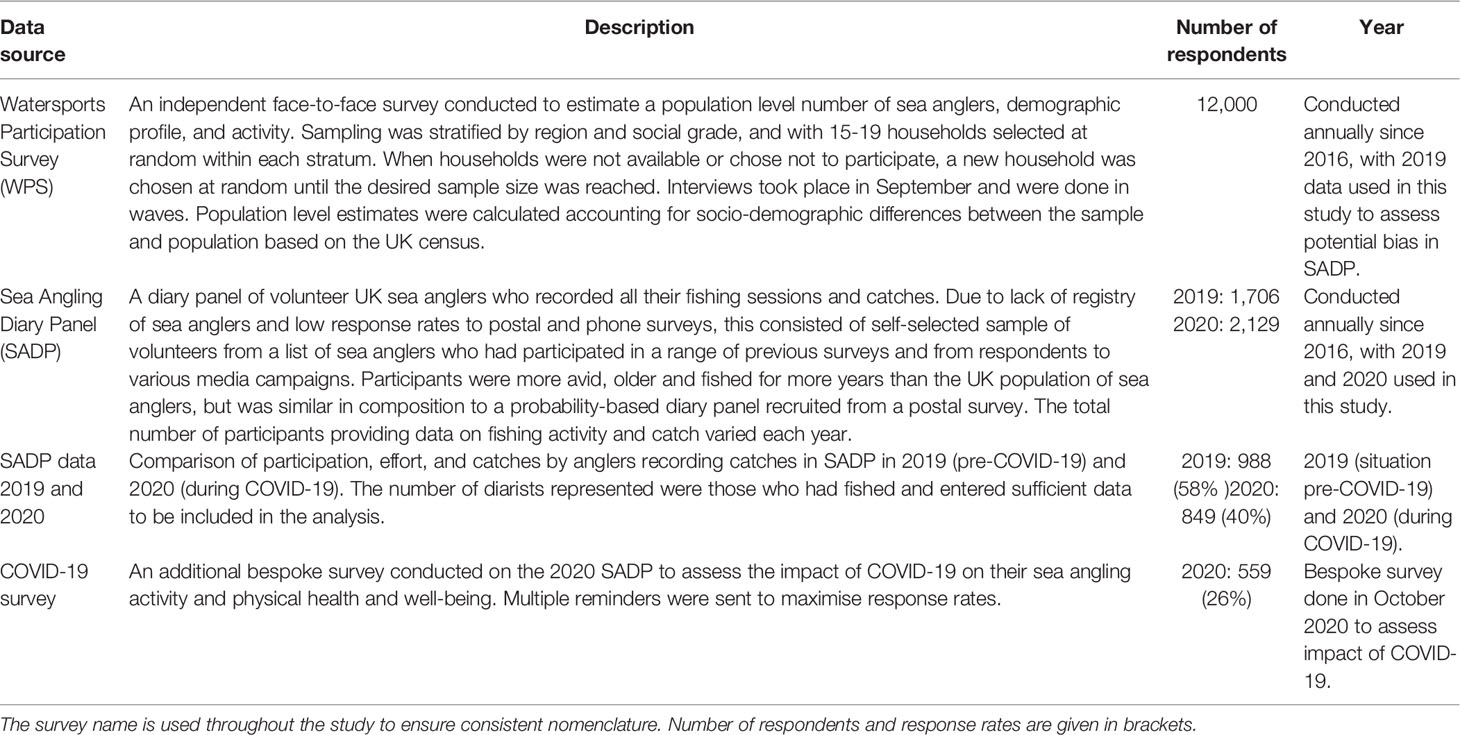
Table 1 A glossary table of the different sources of data used to assess the impacts of COVID-19 on UK sea anglers.
To understand the impact of COVID-19 on UK recreational sea anglers, two approaches were used. Firstly, data on participation, effort, and catches from the existing UK SADP (Hyder et al., 2020a; Hyder et al., 2021) were compared between 2019 and 2020 to assess the impact on numbers, travel to angling locations, and catches on individual angling trips (hereafter termed SADP data 2019 and 2020; Table 1). Secondly, an additional bespoke survey was conducted of anglers participating in the UK SADP (Hyder et al., 2020a, 202) about the impact of COVID-19 on their sea angling and physical health and well-being (COVID-19 survey; Table 1).
Comparing Sea Angling Effort, Locations, and Catches in 2019 and 2020
To assess the impact of COVID-19 on fishing activity, outputs from the sea angling the SADP effort and catch survey in 2019 and 2020 were compared (SADP data 2019 and 2020; Table 1) (Hyder et al., 2020b; Hyder et al., 2021). SADP participants were encouraged to use an online tool and mobile app after every fishing session, to record their activity, such as fishing location, number of catches (kept and returned) and type of equipment used. They were asked to complete information for each month of the year about whether they have fished or not in that month, their sessions in that month (location, duration, method, platform), and all their catches for each session including species, length and numbers caught, kept and returned. The number of sessions reported, the number of diarists reporting fishing, fishing locations, and catches (kept and returned) was extracted from the database for each month in 2019 and 2020. Seasonal patterns were plotted for the two years for the number of sessions reported, numbers of sessions per diarist on each platform, numbers of diarists fishing, catch rates per trip, locations of trips and distances travelled. These SADP data 2019 and 2020 were interpreted in the context of periods of lockdowns and restrictions that impacted access to sea angling in the UK.
Assessing the Impacts of COVID-19 on Sea Angling
To understand the impact of COVID-19 on UK recreational sea anglers, an online COVID-19 survey was conducted on the SADP. At the time of the research, the panel consisted of 2,129 adults (16 years of age and over) who were recreational sea anglers. Sea anglers on the panel were sent a link to the online survey through Survey Monkey (https://www.surveymonkey.co.uk/). They provided consent to participate before completing the survey and no identifying personal data (email or name) were collected. The survey was sent on the 1st October 2020 and a reminder was sent to the same audience on the 27th October 2020 before responses were closed on the 1st November 2020.
Survey Design
The survey was designed to collect a range of data about respondents, including their normal or perceived (pre-COVID-19) sea angling activity (Supplementary Materials Q1–Q10); the impact of COVID-19 on their sea angling activity (Supplementary Materials Q11– Q28); and sections to assess impacts on physical activity, well-being and sea angling-related expenditure. The survey also asked about their anticipated sea angling activity in the near future and demographic questions to provide a profile of respondents. The survey questions are included in Supplementary Materials.
Sea Angler Profile
The first section of the survey was designed to provide information so that the sea angling profile of respondents could be compared to other data (such as that held on the SADP). This asked about the avidity of the respondent in the preceding 12 months; the platforms they usually fished from; other forms of angling they have done; their normal mode and distance of travel to sea angling; and some questions to assess the centrality of sea angling to their lifestyles, their skills, their retention of fish and the months in which they had been sea angling in 2020. Demographic questions asked about age, sex, physical and mental health disability and ethnicity (Sport England, 2021) as well as employment status and postcode.
Sea Angling Activity During COVID-19
The second section was designed to gather data about in which months (March – September 2020) the COVID-19 pandemic had prevented them from going sea angling; the most important reason that had prevented them from going sea angling (government restrictions, isolation, minimizing risk, or other reasons); which of those months they would normally have fished; whether they had fished since restrictions were lifted or partially lifted; and whether that had been at a higher or lower rate than normal for that time of year. These questions were designed to assess not only the direct effect of COVID-19 on their sea angling in 2020, but also to provide counterfactual data on what they might have done if the COVID-19 pandemic had not happened.
Physical Activity Levels
The third section asked respondents about the effect that not being able to go sea angling had on their physical activity levels. They were provided with a series of statements about the effect of not sea angling on their physical activity and asked to rank these on the Likert five-point scale from whether they ‘strongly agreed’ to ‘strongly disagreed’. The statements provided were designed to identify causal relationships between not sea angling and lower levels of physical activity. Respondents were also given the opportunity to provide a qualitative statement about the impact of COVID-19 on their activity.
Impact of COVID-19 on Well-being
The World Health Organization Five Well-being Index (WHO-5) was used as a self-reported measure to determine the impact of not going sea angling on respondents’ well-being (WHO, 1998; Topp et al., 2015). Following the same format for the physical activity questions, respondents were asked to what extent they agreed or disagreed with a series of statements about their well-being, adapted from the WHO-5 well-being indicators. Following this, respondents were provided with the WHO-5 self-reported measures and asked about their well-being in the preceding two weeks, followed by a question asking them to relate their responses to their ability to go sea angling to provide some data on causal relationships between sea angling and well-being.
Impact of COVID-19 on Angler Participation, Effort and Expenditure
The final set of ‘impact’ questions asked respondents to say what their expenditure on sea angling had been in April 2020 (when no sea angling was allowed in the UK) and what they would spend in a ‘normal’ April. This allowed some analysis of the impact of not being able to go sea angling on sea angling-related economic expenditure. Following this, respondents who had been able to go sea angling since the initial lockdown in April were asked about how COVID-19 had affected their sea angling behaviour – such as whether they had travelled further or less distance than usual, avoided crowded places or not participated on charter boats. Finally, some data suggested that the pandemic had led to more people taking up fishing: in England, the Environment Agency, which manages freshwater fishing, said that sales of licence to fish in freshwater had increased by 17% in 2020 (Environment Agency, 2020). To help assess whether the pandemic had led to more people fishing in the sea as well, respondents were asked whether they had taken people fishing who had not fished before or if they knew of people who had either fished for the first time or returned to fishing after a break-in 2020.
Statistical Analysis
A generalised linear model was used in R statistical computing environment (R Core Team, 2015) to determine predictor variables that could impact the WHO-5 score (WHO, 1998; Topp et al., 2015). To determine the impact of COVID-19 on the participation rates, effort and expenditure of sea angling a Wilcoxon t-test was used to compare the number of days fished and expenditure in 2019 vs 2020 in PAST- Paleontological Statistics v4.0 (Hammer et al., 2001). Multinomial logistic regression was used to examine which predictors affect whether respondents spent more or less on angling (compared to no change) in April 2020 compared to a typical April. The ‘no change’ category was defined as the reference level.
Results
Respondent Profile
In total, we received 635 (30%) responses to the survey, of which 559 (26%) respondents completed the survey. There was a bias in age and gender, as there is in the SADP generally, where respondents were generally more likely to be male and older in comparison to the UK sea angler population (Table 2). As expected, the location of the respondents matched the SADP location profile, which is also somewhat different to the UK sea angler population (Table 2). The bias in the SADP which was older, more avid male sea anglers, and therefore our responses to the COVID-19 survey, has been defined and analysed in Hyder et al. (2020a).
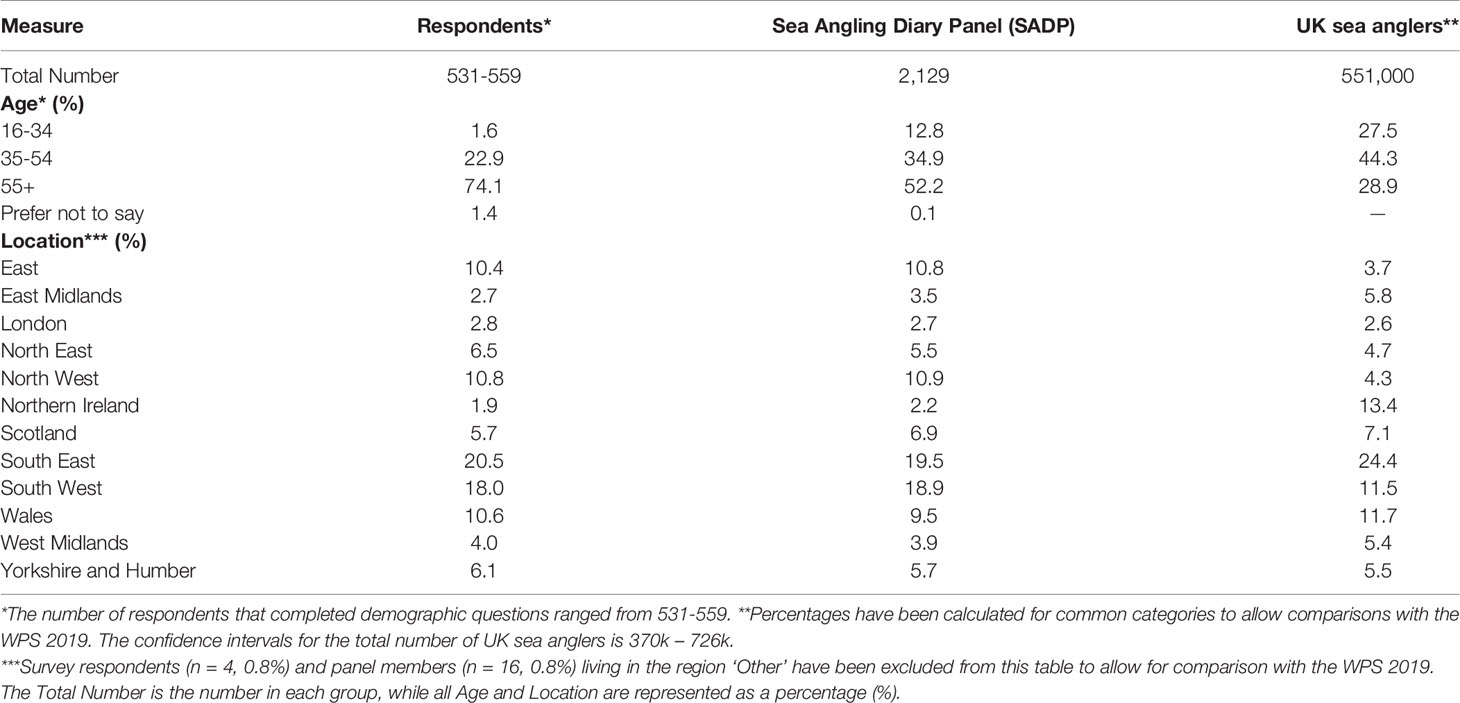
Table 2 Characteristics of the respondents to survey in comparison with the whole Sea Angling Diary panel and the UK population of sea anglers in 2019.
Comparing Sea Angling Effort, Locations, and Catches in 2019 and 2020
The number of sessions reported by anglers in 2020 decreased significantly from February with almost no sessions reported in April 2020. The average number of sessions per angler exceeded 2019 figures in July-September 2020 and matched 2019 later in the year (Figure 1A). The proportion of anglers fishing per month in 2020 followed a similar pattern to the average number of sessions reported, with a significant decrease in comparison to 2019 levels with some recovery from July onwards (Figure 1B). The average catch per angler reported in 2020 remained lower than those reported in 2020, with April reporting the largest difference and numbers recovering in the summer months (Figure 1C). The total distance travelled by anglers from their home to their session site was significantly lower in April 2020 compared with the same month in 2019 (Figure 1D). Total distances did not recover to pre-COVID-19 levels until August and then followed a similar pattern in the autumn and winter months compared with 2019.
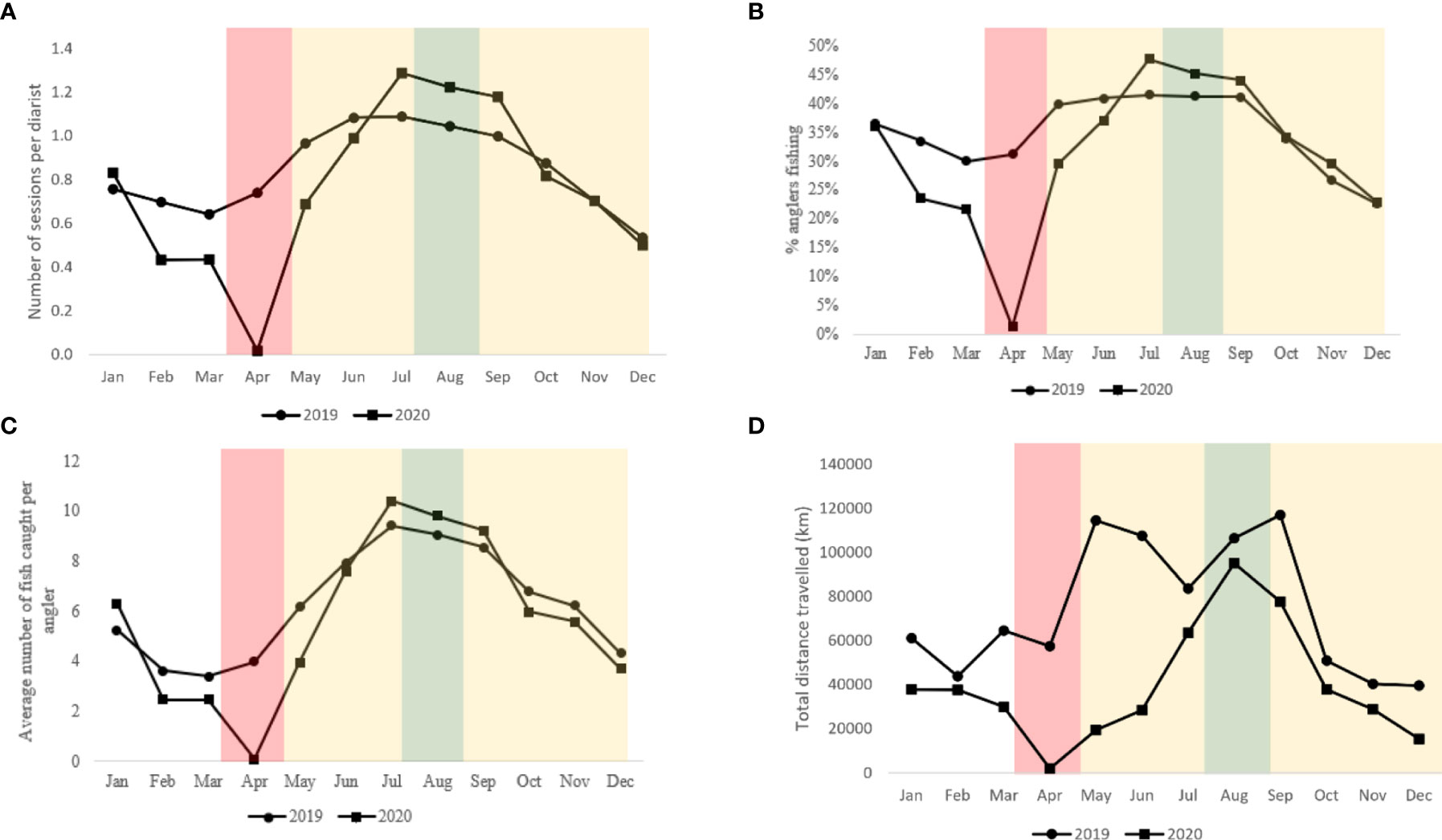
Figure 1 Seasonal patterns of angling activity and catches in 2019 and 2020, generated from the UK sea angling surveys. (A) the average number of sessions per diarist per month; (B) the proportion of anglers that fished each month; (C) the average catch per angler; (D) the total distance travelled by anglers from their home location to their fishing site per month (totals for distance travelled were used instead of averages due to a wide variation in session numbers). Red represents the full lockdown, yellow is a partial lockdown, green is when the lightest restrictions were in place, no colour is prior to COVID-19 pandemic lockdowns.
Assessing the Impacts of COVID-19 on Sea Angling
Respondent Effort and Participation
Anglers were significantly less likely to fish in each month from March to September in 2020 than in a typical year (Wilcoxon: p < 0.001). April represented the largest change between a typical year and 2020, where 57% of individuals who would have typically have gone sea angling did not do so (Figures 2A, 3). For individuals who were not able to go sea angling in particular months, the single most important reason was that there were government lockdowns or restrictions on travel/activities (54%), followed by their own decision to minimise risk (21%). The main reason for not fishing in March and April was due to government lockdown or restrictions on travel/activities (67%) (Figure 2B). In August and September, 18% of individuals reported they made their own decision not to fish to reduce risk, whilst 57% of individuals reported that they were not restricted and therefore this did not prevent them from fishing (Figure 2B).
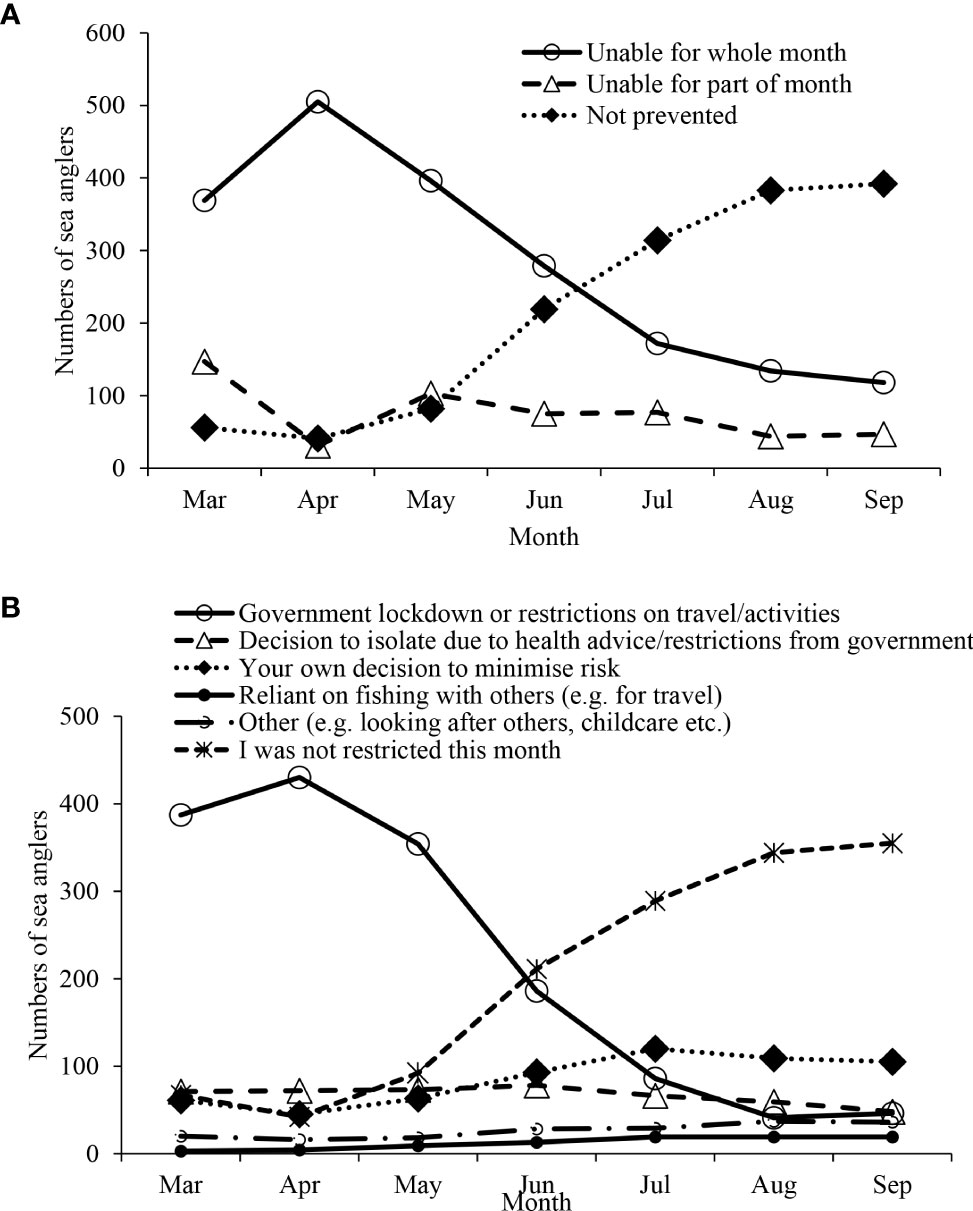
Figure 2 Impact (A) Impact of COVID-19 on the ability of the respondents to access sea angling. (B) Reasons for not fishing during COVID-19 across respondents to the survey. As lockdown rules varied across the UK and people were shielding, this is not simply related to the periods of nationwide lockdown.
The survey found that 45% of anglers had chosen to fish in places where they could avoid other people, and this was more than they would normally have done (Figure 4). Cited reasons in the qualitative responses included crowding at their regular fishing spots (either public use of the beach or increased numbers of other anglers): “When lockdown ceased the coast was swamped with people, so I couldn’t/didn’t want to fish in amongst the crowds”; and “Far more anglers on the beach than pre-pandemic. Many people, non-anglers, on the beach and in the sea, therefore, could not guarantee fishing safety for all nor able to ensure social distancing.” Most anglers (58%) reported that they did not know other people who had not fished before who have done so since the COVID-19 crisis began (Figure 5).
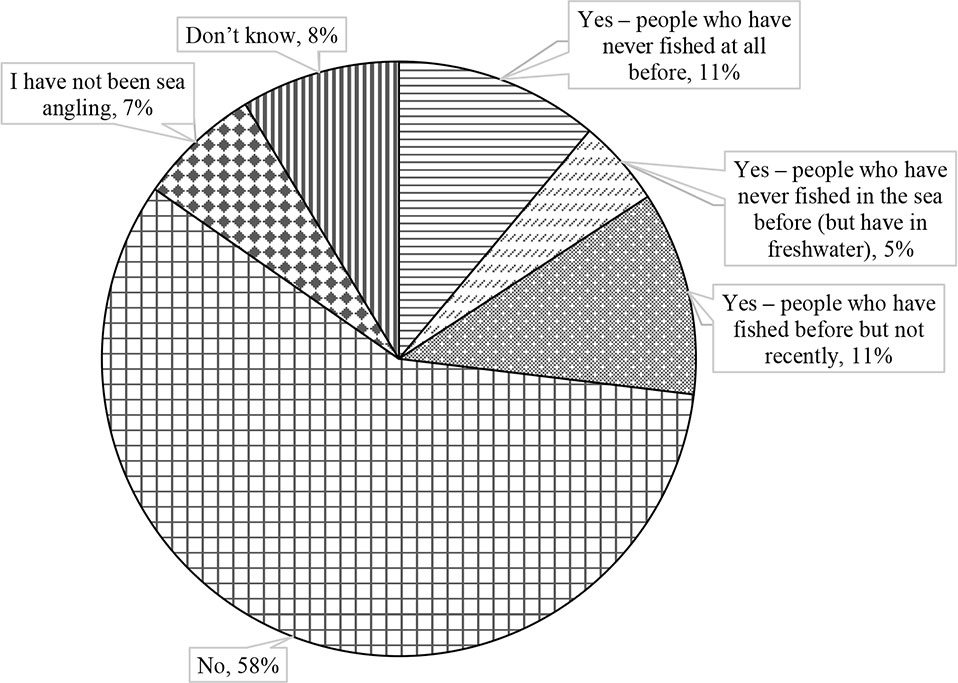
Figure 5 Changes in participation in sea angling during COVID-19. Responses to the question: Do you know of other people who have not fished before who have done so since the COVID-19 crisis began? Please tick all that apply.
Expenditure
There was a significant difference in people’s sea angling expenditure when comparing spending in a ‘typical April’ to spending in April 2020 (Wilcoxon test: p < 0.001). In total, 363 (63%) people had spent less, 161 (28%) reported no change in their spending and 51 (9%) people has spent more in April 2020 than they typically would on sea angling.
The difference between the nominal values of individual usual spending during a ‘typical April’ and spending in April 2020 was calculated, and respondents were placed into one of three categories; no change, spent less, or spent more. A multinomial regression model was conducted to determine which variables affected whether an individual was more likely to spend more or less in April 2020 compared to a typical April. This was examined in relation to ‘no change’, which was used here as the reference category. The centrality of angling to angler’s lifestyle was a predictor (coef – 0.11, p <0.05) for spending less in April 2020 compared to a typical April (Table 3), in addition to their mental health and well-being score (WHO-5). Fishing in 2020 (at least once) was a significant predictor for a change in spending, both for spending more (coef = 1.4, p <0.001) and spending less (coef = 0.2, p <0.001). Avidity influenced the probability of spending more in April 2020 with more regular anglers more likely to spend more (coef=0.193, p<0.001). Those who have fished only once or not at all in the last 12 months less likely to spend more in April 2020 (coef = 58.88, p <0.001 and coef = -42.35, p <0.001, respectively). Anglers that fished more in April 2020 compared to a typical April were significantly more likely to have spent more (coef = 3.08, p = 0.051). Anglers that fished the same amount in April 2020 compared to a typical April, in addition to those who did not fish at all in April 2020, were significantly likely to have had a change in spend, both spending more and spending less relative to the no change in expenditures (Table 3).
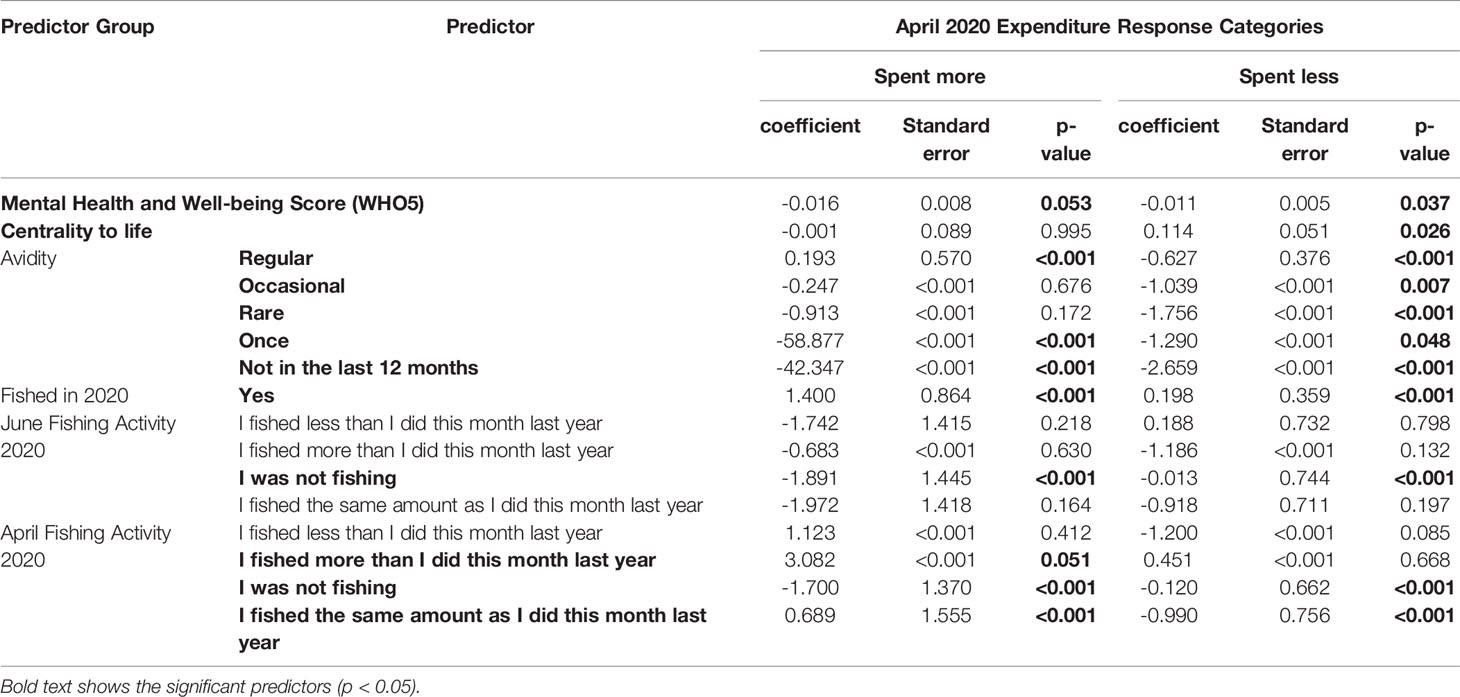
Table 3 A multinomial logistic regression of the predictors impacted whether respondents spent more, less or no change on angling in April 2020, compared to a typical April.
Physical Activity
During COVID-19, 45% of respondents felt that they were less active because they could not go sea angling, while 21% agreed that they were less active for other reasons (Figure 6A). Individuals who had either or both a mental and physical health concern (66%) were more likely to be less active because they could not go sea angling when compared to individuals who had neither health concern (38%). Unemployed individuals were more likely to agree or strongly agree that they had been less active because they could not go sea angling (77%) compared to individuals employed (41%), furloughed (40%), or retired (44%). Comparisons based on gender was not possible due to the very low number of female respondents (n=6).
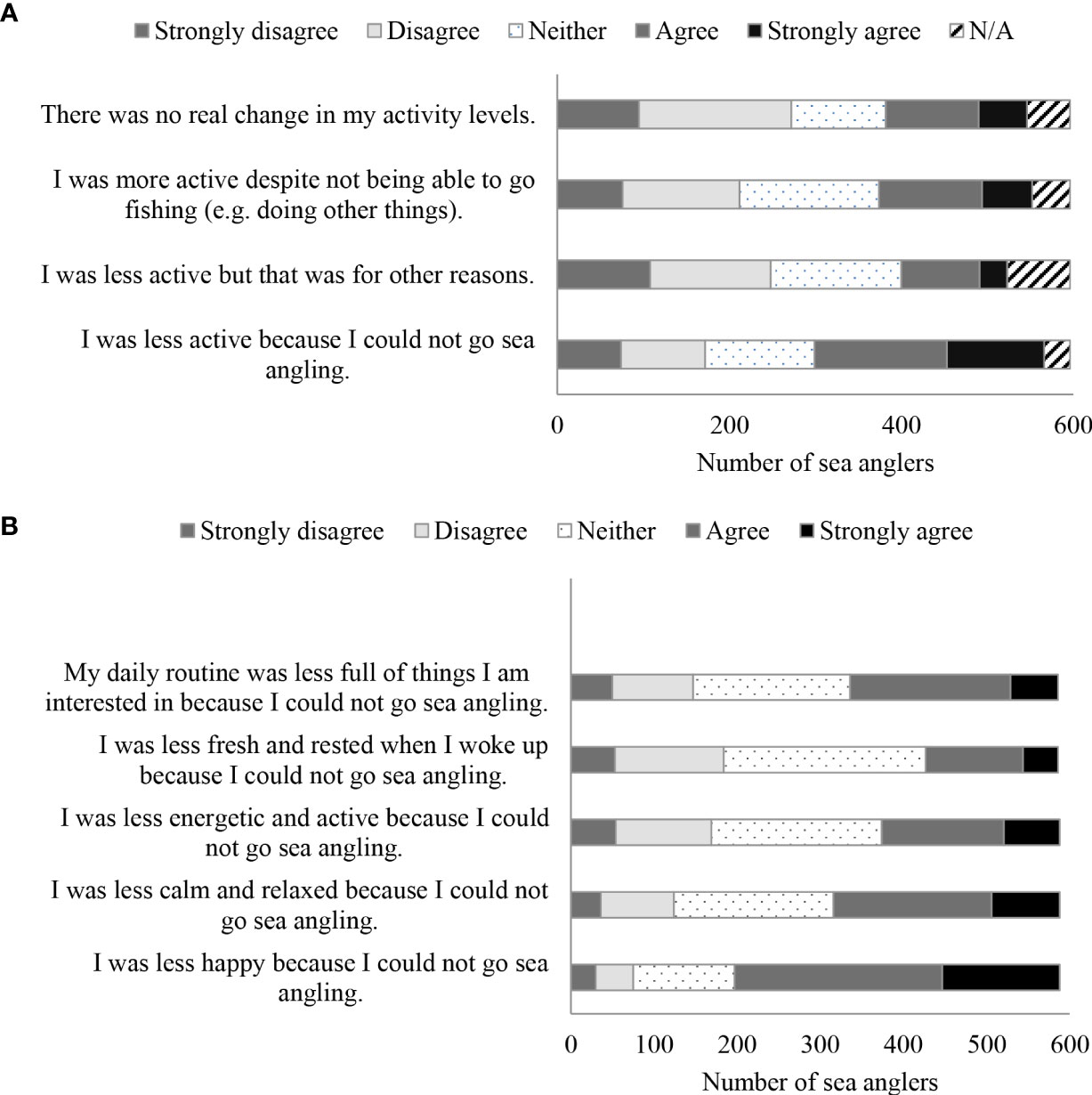
Figure 6 The role of COVID-19 on impacting levels of physical health (A) and well-being (B) and the relative importance of sea angling as a driver.
Well-being
In a subjective measure, respondents were asked to recall the impact of not being able to go sea angling in 2020 had on their well-being. 43% of respondents reported that not being able to go sea angling because of COVID-19 had some form of negative impact on their well-being. For example, 67% said that they ‘strongly agreed’ or ‘agreed’ that they were less happy because they could not go sea angling (Figure 6B).
The well-being of individuals in the preceding two weeks was scored using the WHO-5 methodology (Figure 7A). Anglers were also questioned as to what extent their responses to the WHO-5 measures about their well-being in the preceding two weeks were due to being able to go sea angling (Figure 7B). 67% of anglers said their responses were due to being able to go sea angling. Of these 67% had a high well-being score (67%-100%), 26% had a medium well-being score (33%-66%) and only 7% had a low well-being score (0-33%) (Q19, Supplementary Materials).
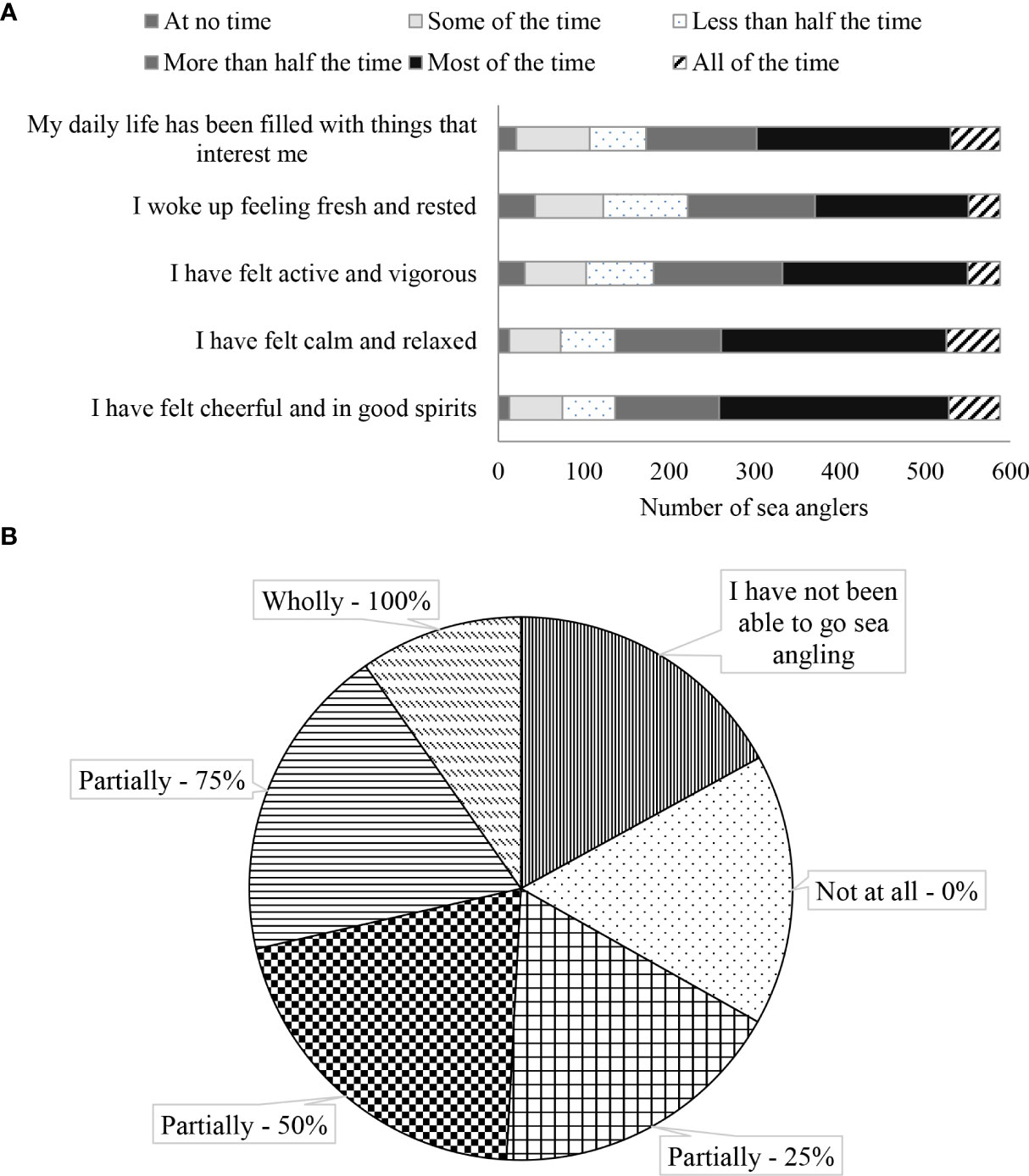
Figure 7 (A) Response from participations on well-being in the last two weeks (Supplementary Material Q20) and (B) how important restrictions on sea angling are for these outcomes (Q21 To what extent are your responses due to now being able to go sea angling? Please say from 0% (not at all) to 100% (completely due to sea angling), or tick N/A.; Supplementary Material).
Using a general linear model, we reviewed the other responses as possible variables that could affect individual well-being scores (Table 4). We tested all predictor groups within the survey and included those that were significant in the model. We found that even though anglers said that being able to go fishing has resulted in high WHO-5 scores, age, physical and mental health status, angling activity, travel to fish during COVID-19, and July fishing activity in 2020 had significant effects (p < 0.05, SE = 15.04, Table 4). For example, individuals with a WHO-5 score that was positively impacted by their ability to go sea angling were more likely to have a mental or physical health issue, or both (p = <0.001 to 0.29, SE = 2.54 to 4.88, Table 4).
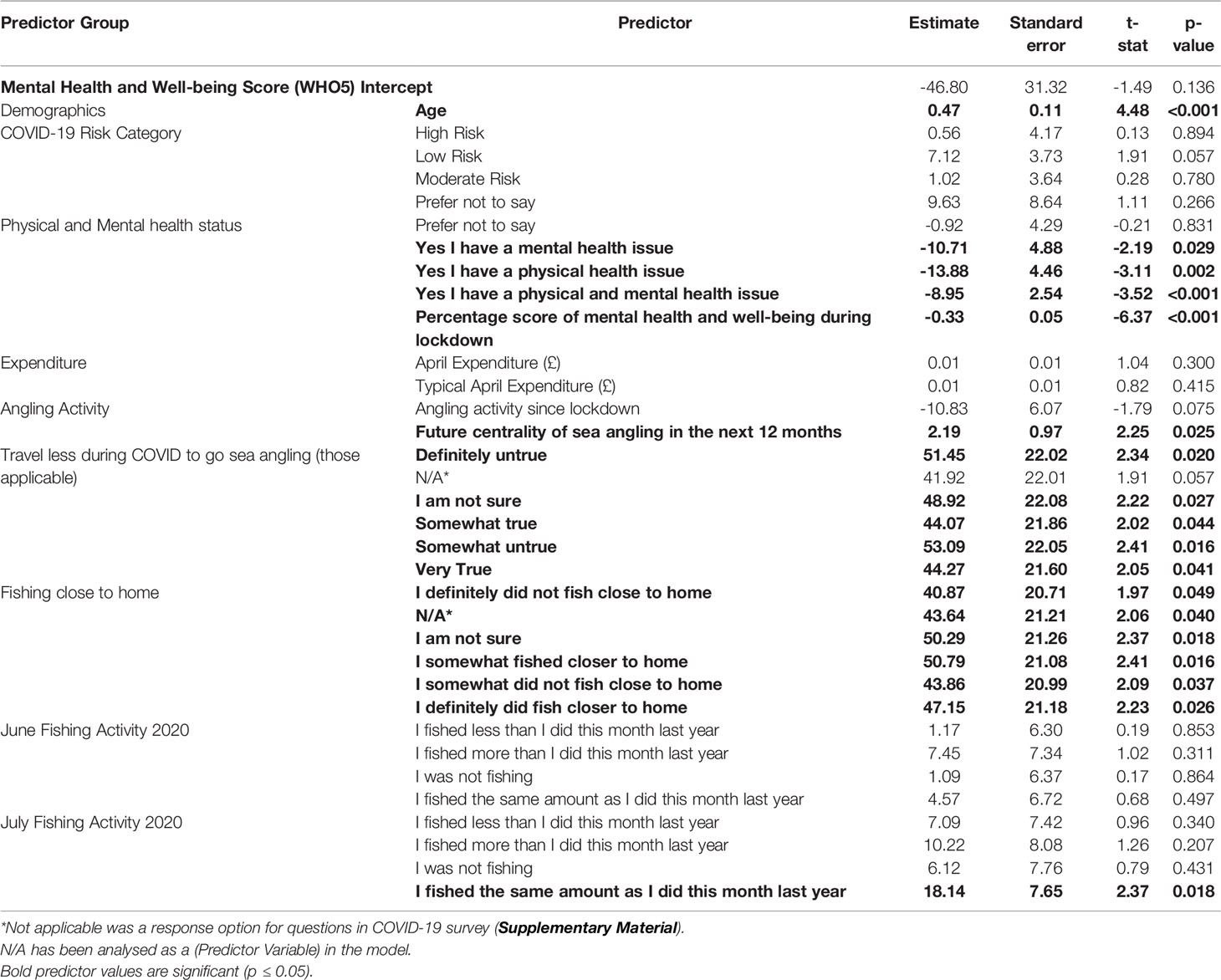
Table 4 A generalised linear model of the impact of multiple predictors on the mental health and well-being of sea anglers
Discussion
Using the evidence collected, we can conclude that COVID-19 had an overall negative impact on recreational sea angling in the UK in 2020, especially during the first lockdown in April 2020. This included participation and effort, physical activity, well-being, and expenditure of sea anglers. This confirms our hypothesis that there was a reduction in sea angling effort as a result of lockdowns, other restrictions, and personal circumstances that limited angling activity. There remains an unknown long-term effect of this negative impact on recreational sea angling especially as the pandemic continues, which could affect restrictions, personal health, or willingness to fish. Participation and effort were negatively affected for many sea anglers by lockdown, health concerns and other personal circumstances related to COVID-19, which impacted mental well-being and physical activity. When reviewing diarist participation in sea angling during COVID-19 in 2020, we found an overall reduction in the number of diarists fishing, number of sessions and number of catches. The data shows that the number of sessions per diarist increased during July, August and September of 2020 suggesting compensation of activity for when it was restricted. In total, 67% of respondents reported reduced happiness and 45% were less active due to sea angling restrictions.
Although surveying anglers has been a common practice in the management and understanding of angler behaviour (Pollock et al., 1994) this survey was limited in nature by some factors. The population surveyed was a research panel of sea anglers in the UK created to provide data for the SADP on participation, catches and expenditure. The SADP is itself self-selected and previous analysis has shown some bias as they are generally older, more avid, and had been fishing for more years when we compare them to the general population of sea anglers (Hyder et al., 2020a). It is suggested that the participants are more engaged in angling and therefore more likely to sign up to the diary project (Hyder et al., 2020a), and were more likely for the restrictions to have affected their well-being because they were unable to fish. The respondents to this survey were a self-selected sample of that panel and as such cannot be taken to be representative of the sea angling population of the UK. However, this study is unique in that it has years of evidence that define and account for bias in the sample size. The reasons that this approach was taken are that there is no database of sea anglers in the UK from which a representative sample of sea anglers could be drawn; alternative methods such as a randomized face-to-face survey (Pollock et al., 1994; Mosindy and Duffy, 2007) were not possible during the pandemic and this, and other methods, such as postal surveys would have been prohibitively expensive. Unlike other countries, the UK does not have a licence nor a registry for sea anglers, there is no legal requirement for catch reporting, and response rates to mail and telephone surveys in the UK are low, making probability-based samples very difficult to obtain. Despite the use of a convenience sample, a small UK sea angling diary panel recruited from a randomised postal survey had similar demographic characteristics (Hyder et al., 2020b). Research into mandatory catch reporting in freshwater has resulted in provision of up to a 99% of data where there was commitment and investment from anglers, angler enforcement, and robust fisheries management (Lyach, 2021). However, there are fewer species to record and manage in freshwater compared to the marine environment in the UK (Winfield, 2016), and sea angler preferences for voluntary catch and release for some species (Andrews et al., 2021). The timescale for capturing some data on the impact of the pandemic to avoid recall bias was short, so the most efficient approach was to use the SADP. However, other biases in the sample could include participants not wishing to report angling during legally enforced lockdowns, or generally not including limited or unsuccessful sea angling trips when there is no catch to report (Essig and Holliday, 1991; Hartill and Edwards, 2015). This could have an impact on the true numbers of sessions and economic impact of UK recreational sea angling. A larger, more representative diary panel, with a randomized representative sample, might help address these issues in future surveys. Reweighting the sample to account for bias was not possible, as COVID-19 resulted in the change of WPS methods from face-to-face to online panel in 2020, so different could be due to survey method rather than COVID-19. Finally, the comparison made in the longitudinal survey was used to assess relative changes rather than absolute numbers, which should be robust as long as the bias is consistent. Although the impact of this bias is unknown and we can assume from other research that overall COVID-19 had a negative effect on sea anglers, especially during the first lockdown. However, it is likely that other circumstances of COVID-19 caused greater impact and that not being able to go sea angling was not the only cause.
This survey was taken at a specific point in time to assess the immediate impacts of the COVID-19 pandemic mid-way through 2020. It was designed with an expectation that the pandemic restrictions would likely be short-lived and the survey took place before the second wave and subsequent second lockdown in the UK from 2020 to 2021. To investigate the further effects of the pandemic and the second lockdown on angler participation, physical activity, well-being and expenditure, a subsequent survey on the longer-term impacts of COVID-19 on sea angling could be conducted. Currently, the SADP does not collect information at each session on sea anglers’ physical activity, well-being and expenditure, although these factors are surveyed periodically. More regular surveying of these factors could help future comparisons and assessment of impact. It can be seen from the participation levels in the SADP results, those diarists who continued to fish as the second lockdown came into force in December 2020, although this was overall lower than in 2019. Overall, we cannot say whether or not sea angling participation or effort increased in the UK population. Our survey was conducted on existing participants in sea angling, and their responses on whether they knew someone who had taken up angling were not informative enough to contribute any significant information about participation or effort increases.
A change in people’s exercise routines, prolonged (two weeks or more) self-quarantine and government-imposed social distancing and isolation negatively impacted well-being, such as an increase in stress and depression (Hawryluck et al., 2004; Dwyer et al., 2020). There is a base of knowledge that explains the benefits of being in nature for health and well-being (Chaudhury and Banerjee, 2020; O’Brien and Forster, 2020). In the UK generally, there was an increased desire to spend more time amongst nature following lockdown (Lemmey, 2020), which is an integral part of recreational sea angling and is an important motivation for going sea angling (Brown, 2019). However, for some individuals, access to nature was restricted during the pandemic, specifically during lockdowns, and there was likely a negative impact as the added value of exercising in nature was not realized. To understand the more general impact of sea angling on physical activity, well-being, and expenditure in 2021, we will be conducting two new surveys. These surveys utilize an expanded set of questions about impact in these areas based (in part, where possible) on additional validated measures. These data will provide a set of findings some of which will allow comparative analysis to the results presented here and help us understand further information about the impact of the pandemic on anglers during 2021. Analysis of SADP data and national participation data from 2019 will further explore how patterns of participation have changed between 2019, 2020 and 2021.
Prior to the pandemic, participation in recreational angling has been on an overall steady decline. Although participation in sea angling has fluctuated between 2016 to 2019 (Hyder et al., 2020a), freshwater licence sales declined dramatically in the decade before the pandemic (Environment Agency, 2020). Other countries have reported an increase in recreational angling in a similar period, however different methods of survey and modelling to manage angling were used (Hartill and Edwards, 2015; Arostegui et al., 2021). In 2020 countries, including England, Germany, Belgium, and Greece, reported that participation in freshwater recreational angling had increased. For example, in Belgium, there was a 30% increase in licence sales compared to 2019 (Gundelund and Skov, 2021; Pita et al., 2021). In Germany, it was argued that there had been a shift in recreational angling from marine to freshwater, and globally this shift has been beneficial to species under recreational fishing pressure (Pita et al., 2021). In England, the increase in licence sales suggested that more individuals were angling, and it may have been the case that more individuals are likely to be sea angling (gov.uk, 2020; Pita et al., 2021). However, although participation may have increased, our data suggest that effort decreased and those surveyed were sea angling less often in 2020 than in 2019. However, this sample may be more experienced, avid and older than the general population. In other countries, the COVID-19 outbreak lockdowns resulted in a higher participation rate and a change in angler characteristics, such as in Denmark, where individuals were more likely to be younger and less experienced when compared to previous years (Gundelund and Skov, 2021). There is currently no data that allows assessment of whether there were changes in participation and effort between fishing in freshwater and fishing in the sea, although this could be collected in future surveys. In some countries, the lockdowns did not prohibit sea angling, such as in North America, where 92% of jurisdictions did not close or delay recreational fishing and in some, it was even encouraged as a safe activity (Paradis et al., 2021). It was and remains recognized that lockdowns had direct and indirect effects on individual health and well-being, however, these have yet to be fully explored. An important factor in this research, which included anglers from across the UK, was that the restrictions and personal circumstances faced by citizens during 2020 varied enormously, from country to country, region to region and month to month. The only time in which there was a uniform approach to restrictions across the whole of the UK was in April 2020 and it is the results relating to this period that are perhaps the strongest.
The impact of the first lockdown in the UK saw a reduction in participation, effort and spending in sea angling. Most individuals (63%) spent less than a typical April during the lockdown, indicating an economic impact in the recreational sea angling sector. An expected significant predictor of this change was whether or not an individual fished at all in 2020, their fishing activity in April 2020 (the month of angling restrictions), their stated avidity and how central recreational sea angling was to their lives. Centrality to lifestyle was a significant predictor of a decrease in spending on angling. This is likely due to the impact of the pandemic on participation rates, as individuals were unable to go angling at the same rate as in previous years. Interestingly, whether or not an individual fished in June and their mental health and well-being score, WHO-5, were also predictors. The summer months often provide more opportunities to fish, and in 2020 we can see from Figure 1, there was a steady increase in recreational angling through to August. Despite the WHO-5 being a predictor for their expenditure, expenditure was not a predictor for WHO-5. Although those who have been able to go back to sea angling have a high or medium WHO-5 score, we found that other factors had significant effects, such as age, physical and mental health status, angling activity, travel to fish during COVID-19, and July fishing activity in 2020 had significant effects (p <0.01, Table 4). In other studies of the general population in the UK, females reported higher levels of anxiety than males (White and Boor, 2020). In our study, there was a lower number of females (N = 6), which is also found in the general UK sea angling population but not to the same degree. However, it was estimated that up to 20% of all UK sea anglers are female (Hyder et al., 2020a), while only 1.1% of the responses in the COVID-19 survey were female. This could have been due to the survey being conducted on a known panel of sea anglers, rather than being conducted on the general population through random sampling. White and Boor (2020) also found that respondents who reported either self-isolating before the lockdown, increased feelings of isolation after the lockdown and having livelihood concerns due to COVID-19 had a higher association with poorer mental health and well-being (WHO-5) (White and Boor, 2020). It would have been interesting to gather further information regarding the general impact of COVID-19 on participants, to measure the quality of life (WHO-QOL BREF) (Skevington et al., 2004; WHO, 2012), perceived stress (PSS-10) (Cohen et al., 1983), depressive symptoms (PHQ-9) (Spitzer et al., 1999) or anxiety (GAD-7) (Spitzer et al., 2006). This may have also improved the analysis and understanding of the impacts of COVID-19 and sea angling, especially if comparing individuals who had been angling in the previous two weeks from the time of taking the survey.
As the first study to understand the impacts of COVID-19 on sea anglers in the UK, we have demonstrated some well-being benefits that sea angling can have on participants. Overall, this work has shown that COVID-19 has negatively affected marine recreational fisheries in the UK. We have observed in our sample that not being able to go sea angling had a negative impact on participation, effort, physical activity and well-being. Government and local restrictions, personal health circumstances, aversion of risk and other factors related to the pandemic are reasons participation and effort in sea angling reduced within our sample and therefore subsequently impacted the well-being and physical activity of participants. Similar to other studies in different countries it seemed being able to go sea angling again had a positive impact on our sample, implying that sea angling can make a positive contribution to physical activity and well-being (Lemmey, 2020; Gundelund and Skov, 2021; Howarth et al., 2021; Pita et al., 2021), although other factors can contribute to this. Further research is being conducted in 2021 and 2022 will contribute further data and knowledge to this. This research can contribute to a wider body of knowledge to better inform policymakers about the management of recreational marine fisheries, especially in the event of future pandemics. Lastly, we believe that the longitudinal information regarding the panel surveyed, and the continuing efforts of the SADP to understand marine recreational angling within the UK into 2022, opens scope for further investigation to understand the long-term impacts of COVID-19 on well-being, expenditure, physical activity, and participation.
Data Availability Statement
The datasets presented in this study can be found online through the Cefas data hub (https://data.cefas.co.uk/). Due to the nature of this data and the protection of the respondent's data, requests to access the data should be made directly to the authors.
Ethics Statement
Ethical review and approval was not required for the study on human participants in accordance with the local legislation and institutional requirements. The patients/participants provided their written informed consent to participate in this study.
Author Contributions
All authors set the conceptual framework of this study. SAH, AB and BB carried out the survey and SAH and BB analysed the data with support from KH, ZR, JK and AB. SAH wrote the manuscript with contributions from all authors. All authors contributed to the article and approved the submitted version.
Funding
The research was funded by the Department of Environment, Food and Rural Affairs in England (MI001: Management of Recreational Marine Fisheries) and by the devolved governments of Scotland (RA001: DCF Recreational Sea Angling), Wales (WE001: Recreational Fishing), and Northern Ireland (RA001: DCF Recreational Sea Angling).
Conflict of Interest
Authors SAH, AB, and BB were employed by company Substance. JK was employed by company Radical Data.
The remaining authors declare that the research was conducted in the absence of any commercial or financial relationships that could be construed as a potential conflict of interest.
Publisher’s Note
All claims expressed in this article are solely those of the authors and do not necessarily represent those of their affiliated organizations, or those of the publisher, the editors and the reviewers. Any product that may be evaluated in this article, or claim that may be made by its manufacturer, is not guaranteed or endorsed by the publisher.
Acknowledgments
Thanks to all the sea anglers who have contributed to the Sea Angling Diary project, providing catch and participation data and to those on the panel who responded to the COVID-19 survey, without whom this survey would not have been possible. Thanks to the national angling organisations who have supported the project (the Scottish Federation of Sea Anglers, the Welsh Federation of Sea Anglers, Sport NI, the Irish Federation of Sea Angling, Angling Trades Association), the Association of Inshore Fisheries and Conservation Authorities (IFCAs) and individual IFCAs, Britishseafishing.co.uk, and hundreds of clubs, charter boats and tackle shops who have helped publicise the research. A special thanks to Fishing Megastore who have provided incentives and publicity for the Sea Angling Diary project.
Supplementary Material
The Supplementary Material for this article can be found online at: https://www.frontiersin.org/articles/10.3389/fmars.2022.815617/full#supplementary-material
References
Andrews B., Ferrini S., Muench A., Brown A., Hyder K. (2021). Assessing the Impact of Management on Sea Anglers in the UK Using Choice Experiments. J. Environ. Manage. 293, 112831. doi: 10.1016/J.JENVMAN.2021.112831
Arlinghaus R. (2006). On the Apparently Striking Disconnect Between Motivation and Satisfaction in Recreational Fishing: The Case of Catch Orientation of German Anglers. North Am. J. Fish Manage. 26, 592–605. doi: 10.1577/M04-220.1
Arlinghaus R., Abbott J. K., Fenichel E. P., Carpenter S. R., Hunt L. M., Alós J., et al. (2019). Opinion: Governing the Recreational Dimension of Global Fisheries. Proc. Natl. Acad. Sci. 116, 5209–5213. doi: 10.1073/PNAS.1902796116
Arlinghaus R., Alós J., Beardmore B., Daedlow K., Dorow M., Fujitani M., et al. (2016). Understanding and Managing Freshwater Recreational Fisheries as Complex Adaptive Social-Ecological Systems. Rev. Fish Sci. Aquac. 25, 1–41. doi: 10.1080/23308249.2016.1209160
Armstrong M., Brown A., Hargreaves J., Hyder K., Pilgrim-Morrison S., Munday M., et al. (2013). Sea Angling 2012 - A Survey of Recreational Sea Angling Activity and Economic Value in England (London, UK: Defra), 16 pp.
Arostegui M. C., Anderson C. M., Benedict R. F., Dailey C., Fiorenza E. A., Jahn A. R. (2021). Approaches to Regulating Recreational Fisheries: Balancing Biology With Angler Satisfaction. Rev. Fish Biol. Fish 313 31, 573–598. doi: 10.1007/S11160-021-09662-Y
Astell-Burt T., Feng X. (2021). Time for ‘Green’ During COVID-19? Inequities in Green and Blue Space Access, Visitation and Felt Benefits. Int. J. Environ. Res. Public Heal. 18, 2757. doi: 10.3390/IJERPH18052757
Benefits of Outdoor Sport for Society The BOSS Toolkit - BOSS. Available at: https://outdoorsportsbenefits.eu/toolkit/ (Accessed October 26, 2021).
Beardmore B., Haider W., Hunt L. M., Arlinghaus R. (2011). The Importance of Trip Context for Determining Primary Angler Motivations: Are More Specialized Anglers More Catch-Oriented Than Previously Believed? North Am. J. Fish Manage. 31, 861–879. doi: 10.1080/02755947.2011.629855
Bogoch I. I., Watts A., Thomas-Bachli A., Huber C., Kraemer M. U. G., Khan K. (2020). Pneumonia of Unknown Aetiology in Wuhan, China: Potential for International Spread via Commercial Air Travel. J. Travel Med. 27, 1–3. doi: 10.1093/JTM/TAAA008
Brown A. (2019). “Angling for Good: The National Angling Strategy 2019-2024” in Substance Substance Ltd. (Manchester UK). Available at: https://www.substance.net/feature-pages/nationalanglingstrategy/.
Chaudhury P., Banerjee D. (2020). Recovering With Nature A Review of Ecotherapy and Implications for the COVID-19 Pandemic. Front. Public Heal. 8. doi: 10.3389/FPUBH.2020.604440
Cisneros-Montemayor A. M., Sumaila U. R. (2010). A Global Estimate of Benefits From Ecosystem-Based Marine Recreation: Potential Impacts and Implications for Management. J. Bioeconomics 12, 245–268. doi: 10.1007/S10818-010-9092-7
Cohen S., Kamarck T., Mermelstein R. (1983). A Global Measure of Perceived Stress. J. Health Soc Behav. 24, 385–396. doi: 10.2307/2136404
Ding D., Cruz B., del P., Green M. A., Bauman A. E. (2020). Is the COVID-19 Lockdown Nudging People to be More Active: A Big Data Analysis. Br. J. Sports Med. 54, 1183–1184. doi: 10.1136/BJSPORTS-2020-102575
Dwyer M. J., Pasini M., Dominicis S., De, Righi E. (2020). Physical Activity: Benefits and Challenges During the COVID-19 Pandemic. Scand. J. Med. Sci. Sports 30, 1291. doi: 10.1111/SMS.13710
Eigenschenk B., Thomann A., McClure M., Davies L., Gregory M., Dettweiler U., et al. (2019). Benefits of Outdoor Sports for Society. A Systematic Literature Review and Reflections on Evidence. Int. J. Environ. Res. Public Heal. 16, 937. doi: 10.3390/IJERPH16060937
Environment Agency (2020) Fisheries Annual Report 2018 to 2019 (gov.UK). Available at: https://www.gov.uk/government/publications/fisheries-annual-report-2018-to-2019/fisheries-annual-report-2018-to-2019 (Accessed February 8, 2022).
Essig R. J., Holliday M. C. (1991). Development of a Recreational Fishing Survey: The Marine Recreational Fishery Statistics Survey Case Study. Am. Fish. Soc. Symposium 12, 245–254.
Fedler A. J., Ditton R. (1994). Understanding Angler Motivations in Fisheries Management. Fisheries 19, 6–13. doi: 10.1577/1548-8446(1994)019<0006:UAMIFM>2.0.CO;2
Geary R. S., Wheeler B., Lovell R., Jepson R., Hunter R., Rodgers S. (2021). A Call to Action: Improving Urban Green Spaces to Reduce Health Inequalities Exacerbated by COVID-19. Prev. Med. (Baltim) 145, 106425. doi: 10.1016/J.YPMED.2021.106425
gov.uk (2020) Fisheries Annual Report 2019 to 2020 (GOV.UK: Envrionment Agency). Available at: https://www.gov.uk/government/publications/fisheries-annual-report-2019-to-2020/fisheries-annual-report-2019-to-2020 (Accessed November 4, 2021).
Griffiths S. P., Bryant J., Raymond H. F., Newcombe P. A. (2017). Quantifying Subjective Human Dimensions of Recreational Fishing: Does Good Health Come to Those Who Bait? Fish Fish 18, 171–184. doi: 10.1111/FAF.12149
Gundelund C., Skov C. (2021). Changes in Angler Demography and Angling Patterns During the Covid-19 Lockdown in Spring 2020 Measured Through a Citizen Science Platform. Mar. Policy 131, 104602. doi: 10.1016/J.MARPOL.2021.104602
Guzman V., Garrido-Cumbrera M., Brace O., Hewlett D., Foley R. (2020). Health and Wellbeing Under COVID-19: The GreenCOVID Survey. Irish Geogr. 53, 157–162. doi: 10.2014/igj.v53i2.1420
Hammer O., Harper D. A., Ryan P. (2001). PAST: Paleontological Statistics Software Package for Education and Data Analysis. Palaeontologia Electronica 4, 1–9.
Hartill B. W., Edwards C. T. T. (2015). Comparison of Recreational Harvest Estimates Provided by Onsite and Offsite Surveys: Detecting Bias and Corroborating Estimates. Can. J. Fish Aquat. Sci. 72, 1379–1389. doi: 10.1139/cjfas-2014-0451
Hawryluck L., Gold W. L., Robinson S., Pogorski S., Galea S., Styra R. (2004). SARS Control and Psychological Effects of Quarantine, Toronto, Canada. Emerg. Infect. Dis. 10, 1206. doi: 10.3201/EID1007.030703
Hiscott J., Alexandridi M., Muscolini M., Tassone E., Palermo E., Soultsioti M., et al. (2020). The Global Impact of the Coronavirus Pandemic. Cytokine Growth Factor Rev. 53, 1–9. doi: 10.1016/J.CYTOGFR.2020.05.010
Howarth A., Jeanson A. L., Abrams A. E. I., Beaudoin C., Mistry I., Berberi A., et al. (2021). COVID-19 Restrictions and Recreational Fisheries in Ontario, Canada: Preliminary Insights From an Online Angler Survey. Fish Res. 240, 105961. doi: 10.1016/J.FISHRES.2021.105961
Hyder K., Brown A., Armstrong M., Bell B., Bradley K., Couce E., et al. (2020a). “Participation, Catches and Economic Impact of Sea Anglers Resident in the UK in 2016 & 2017”, in Final Report of the Sea Angling 2016 and 2017 Project (Lowestoft, UK: Cefas), 178 pp.
Hyder K., Brown A., Armstrong M., Bell B., Hook S. A., Kroese J., et al. (2021). Participation, Effort, and Catches of Sea Anglers Resident in the UK in 2018 & 2019 (Lowestoft, UK: Cefas), 79 pp.
Hyder K., Maravelias C. D., Kraan M., Radford Z., Prellezo R. (2020b). Marine Recreational Fisheries-Current State and Future Opportunities. ICES J. Mar. Sci. 77, 2171–2180. doi: 10.1093/ICESJMS/FSAA147
Hyder K., Radford Z., Prellezo R., Weltersbach M. S., Lewin W.-C., Zarauz L., et al. (2017). “Research for PECH Committee – Marine Recreational and Semi-Subsistence Fishing - Its Value and Its Impact on Fish Stocks,” in European Parliament, Policy Department for Structural and Cohesion Policies (Belgium: Brussels), 140 pp.
Hyder K., Weltersbach M. S., Armstrong M., Ferter K., Townhill B., Ahvonen A., et al. (2018). Recreational Sea Fishing in Europe in a Global Context—Participation Rates, Fishing Effort, Expenditure, and Implications for Monitoring and Assessment. Fish Fish 19, 225–243. doi: 10.1111/FAF.12251
Iacobucci G. (2020). Covid-19: UK Lockdown Is “Crucial” to Saving Lives, Say Doctors and Scientists. BMJ 368, m1204. doi: 10.1136/BMJ.M1204
Institute for Government (2021) Timeline of UK Coronavirus Lockdowns, March 2020 to March 2021 (Inst. Gov.). Available at: https://www.instituteforgovernment.org.uk/sites/default/files/timeline-lockdown-web.pdf (Accessed October 26, 2021).
Lemmey T. (2020). Connection With Nature in the UK During the COVID-19 Lockdown (UK: University of Cumbria), 35 pp.
Lewin W.-C., Weltersbach M. S., Ferter K., Hyder K., Mugerza E., Prellezo R., et al. (2019). Potential Environmental Impacts of Recreational Fishing on Marine Fish Stocks and Ecosystems. Rev. Fish Sci. Aquac. 27, 287–330. doi: 10.1080/23308249.2019.1586829
Lu H., Stratton C. W., Tang Y.-W. (2020). Outbreak of Pneumonia of Unknown Etiology in Wuhan, China: The Mystery and the Miracle. J. Med. Virol. 92, 401–402. doi: 10.1002/JMV.25678
Lyach R. (2021). How did the Czech Fishing Union Convince Over 99% of Czech Recreational Anglers to Report Their Harvested Fish and Their Fishing Visits Into Their Angling Logbooks? Sustain 13, 13499. doi: 10.3390/su132313499
Maxmen A. (2021). WHO Report Into COVID Pandemic Origins Zeroes in on Animal Markets, Not Labs. Nature 592, 173–174. doi: 10.1038/D41586-021-00865-8
McCormick L. (2020). Marking Time in Lockdown: Heroization and Ritualization in the UK During the Coronavirus Pandemic. Am. J. Cult. Sociol. 8, 324–351. doi: 10.1057/S41290-020-00117-8
Mcmanus A., Hunt W., Storey J., White J. (2011). “Identifying the Health and Well-Being Benefits of Recreational Fishing,” in Curtin Health Innovation Research Institute (Australia: Curtin University), 64 pp.
McNally S., Bailey S., Banks R., Ritchie J., Connolly A., Milton K., et al. (2015). Exercise: The Miracle Cure and the Role of the Doctor in Promoting It (London, UK: Academy of Medical Royal Colleges), 59 pp.
Mosindy T. E., Duffy M. J. (2007). The Use of Angler Diary Surveys to Evaluate Long-Term Changes in Muskellunge Populations on Lake of the Woods, Ontario. Environ. Biol. Fishes 79, 71–83. doi: 10.1007/s10641-006-9167-4
O’Brien L., Forster J. (2020). “Engagement With Nature and Covid-19 Restrictions Quantitative Analysis 2020,” in Forest Research (UK: Farnham), 49 pp.
Paradis Y., Bernatchez S., Lapointe D., Cooke S. J. (2021). Can You Fish in a Pandemic? An Overview of Recreational Fishing Management Policies in North America During the COVID-19 Crisis. Fisheries 46, 81–85. doi: 10.1002/FSH.10544
Pita P., Ainsworth G. B., Alba B., Anderson A. B., Antelo M., Alós J., et al. (2021). First Assessment of the Impacts of the COVID-19 Pandemic on Global Marine Recreational Fisheries. Front. Mar. Sci. 8. doi: 10.3389/FMARS.2021.735741
Pollock K. H., Jones C. M., Brown T. L. (1994). “Angler Survey Methods and Their Applications in Fisheries Management,” in American Fisheries Society, Special Publication 25 (Maryland, USA: Bethesda), 371 pp.
Potts W. M., Downey-Breedt N., Obregon P., Hyder K., Bealey R., Sauer W. (2020). What Constitutes Effective Governance of Recreational Fisheries?—A Global Review. H. H. Fish Fish 21, 91–103. doi: 10.1111/FAF.12417
Pouso S., Borja Á., Fleming L. E., Gómez-Baggethun E., White M. P., Uyarra M. C. (2021). Contact With Blue-Green Spaces During the COVID-19 Pandemic Lockdown Beneficial for Mental Health. Sci. Total Environ. 756, 143984. doi: 10.1016/J.SCITOTENV.2020.143984
Radford Z., Hyder K., Zarauz L., Mugerza E., Ferter K., Prellezo R., et al. (2018). The Impact of Marine Recreational Fishing on Key Fish Stocks in European Waters. PloS One 13, e0201666. doi: 10.1371/JOURNAL.PONE.0201666
R Core Team (2015). R: A Language and Environment for Statistical Computing. R Foundation for Statistical Computing, Vienna, Austria. Available at: https://www.R-project.org/.
Skevington S. M., Lotfy M., O’Connell K. A. (2004). The World Health Organization’s WHOQOL-BREF Quality of Life Assessment: Psychometric Properties and Results of the International Field Trial. A Report From the WHOQOL Group. Qual. Life Res. 13, 299–310. doi: 10.1023/B:QURE.0000018486.91360.00
Spitzer R. L., Kroenke K., Williams J. B. W., Löwe B. (2006). A Brief Measure for Assessing Generalized Anxiety Disorder: The GAD-7. Arch. Intern. Med. 166, 1092–1097. doi: 10.1001/ARCHINTE.166.10.1092
Spitzer R. L., Kroenke K., Williams J. B. W., Patient Health Questionnaire Primary Care Study Group (1999). Validation and Utility of a Self-Report Version of PRIME-MD: The PHQ Primary Care Study. JAMA 282, 1737–1744. doi: 10.1001/JAMA.282.18.1737
Sport England (2021) Strategic Outcomes Outcome Question(S) Response Options Physical Wellbeing (Activity Level) Measurement & Evaluation 4.2 Sport England Adult Question Bank. Available at: https://evaluationframework.sportengland.org/media/1351/sport-england-adult-question-bank.pdf.
St Martin K. (2007). The Difference That Class Makes: Neoliberalization and Non-Capitalism in the Fishing Industry of New England. Antipode 39, 527–549. doi: 10.1111/j.1467-8330.2007.00538.x
Storr V. H., Haeffele S., Lofthouse J. K., Grube L. E. (2021). Essential or Not? Knowledge Problems and COVID-19 Stay-at-Home Orders. South. Econ. J. 87, 1229–1249. doi: 10.1002/SOEJ.12491
Topp C. W., Østergaard S. D., Søndergaard S., Bech P. (2015). The WHO-5 Well-Being Index: A Systematic Review of the Literature. Psychother. Psychosom. 84, 167–176. doi: 10.1159/000376585
White R. G., Boor C. D. (2020). Impact of the COVID-19 Pandemic and Initial Period of Lockdown on the Mental Health and Well-Being of Adults in the UK. BJ Psych. Open 6, 1–4. doi: 10.1192/BJO.2020.79
WHO (1998). “Wellbeing Measures in Primary Health Care/The Depcare Project,” in Report on a WHO meeting (Stockholm, Sweden: World Health Organization. Regional Office for Europe), 12–13.
WHO (2012) Programme on Mental Health: WHOQOL User Manual (World Health Organization). Available at: https://apps.who.int/iris/handle/10665/77932 (Accessed November 8, 2021).
Wilder-Smith A., Freedman D. O. (2020). Isolation, Quarantine, Social Distancing and Community Containment: Pivotal Role for Old-Style Public Health Measures in the Novel Coronaviru-Ncov) Outbreak. J. Travel Med. 27, taaa020. doi: 10.1093/jtm/taaa020
Winfield I. J. (2016). Recreational Fisheries in the UK: Natural Capital, Ecosystem Services, Threats, and Management. Fish Sci. 82, 203–212. doi: 10.1007/S12562-016-0967-Y/FIGURES/2
World Health Organization (2020) WHO Director-General’s Remarks at the Media Briefing on 2019-Ncov on 11 February 2020. Available at: https://www.who.int/dg/speeches/detail/who-director-general-s-remarks-at-the-media-briefing-on-2019-ncov-on-11-february-2020.
Keywords: marine recreational fisheries (MRFs), recreational sea angling, COVID-19, well-being, physical Activity, participation, effort, United Kingdom
Citation: Hook SA, Brown A, Bell B, Kroese J, Radford Z and Hyder K (2022) The Impact of COVID-19 on Participation, Effort, Physical Activity, and Well-Being of Sea Anglers in the UK. Front. Mar. Sci. 9:815617. doi: 10.3389/fmars.2022.815617
Received: 15 November 2021; Accepted: 14 April 2022;
Published: 31 May 2022.
Edited by:
Simone Libralato, Istituto Nazionale di Oceanografia e di Geofisica Sperimentale, ItalyReviewed by:
Kate Mulvaney, United States Environmental Protection Agency, United StatesRoman Lyach, INESAN (Institute for Evaluations and Social Analyses), Czechia
Stephen Hynes, National University of Ireland Galway, Ireland
Copyright © 2022 Hook, Brown, Bell, Kroese, Radford and Hyder. This is an open-access article distributed under the terms of the Creative Commons Attribution License (CC BY). The use, distribution or reproduction in other forums is permitted, provided the original author(s) and the copyright owner(s) are credited and that the original publication in this journal is cited, in accordance with accepted academic practice. No use, distribution or reproduction is permitted which does not comply with these terms.
*Correspondence: Samantha A. Hook, samantha.hook@substance.net
 Samantha A. Hook
Samantha A. Hook Adam Brown
Adam Brown Brigid Bell
Brigid Bell Jo Kroese
Jo Kroese Zachary Radford3,4
Zachary Radford3,4  Kieran Hyder
Kieran Hyder